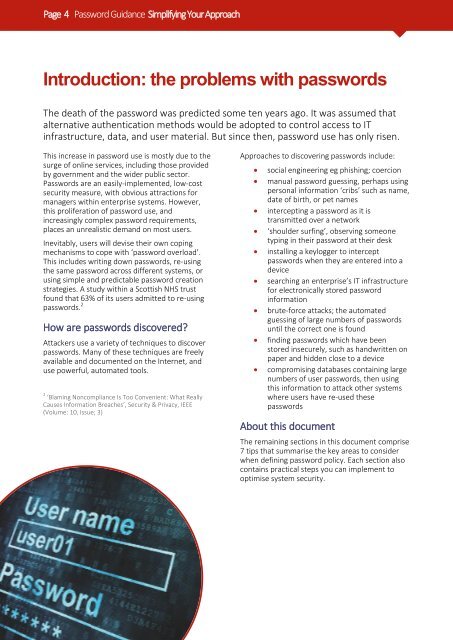Password Guidance
7mBUBUwJA
7mBUBUwJA
- No tags were found...
Create successful ePaper yourself
Turn your PDF publications into a flip-book with our unique Google optimized e-Paper software.
Page 4 <strong>Password</strong> <strong>Guidance</strong> Simplifying Your Approach<br />
Introduction: the problems with passwords<br />
The death of the password was predicted some ten years ago. It was assumed that<br />
alternative authentication methods would be adopted to control access to IT<br />
infrastructure, data, and user material. But since then, password use has only risen.<br />
This increase in password use is mostly due to the<br />
surge of online services, including those provided<br />
by government and the wider public sector.<br />
<strong>Password</strong>s are an easily-implemented, low-cost<br />
security measure, with obvious attractions for<br />
managers within enterprise systems. However,<br />
this proliferation of password use, and<br />
increasingly complex password requirements,<br />
places an unrealistic demand on most users.<br />
Inevitably, users will devise their own coping<br />
mechanisms to cope with ‘password overload’.<br />
This includes writing down passwords, re-using<br />
the same password across different systems, or<br />
using simple and predictable password creation<br />
strategies. A study within a Scottish NHS trust<br />
found that 63% of its users admitted to re-using<br />
passwords. 2<br />
How are passwords discovered?<br />
Attackers use a variety of techniques to discover<br />
passwords. Many of these techniques are freely<br />
available and documented on the Internet, and<br />
use powerful, automated tools.<br />
2 ‘Blaming Noncompliance Is Too Convenient: What Really<br />
Causes Information Breaches’, Security & Privacy, IEEE<br />
(Volume: 10, Issue; 3)<br />
Approaches to discovering passwords include:<br />
<br />
<br />
<br />
<br />
<br />
<br />
<br />
<br />
<br />
social engineering eg phishing; coercion<br />
manual password guessing, perhaps using<br />
personal information ‘cribs’ such as name,<br />
date of birth, or pet names<br />
intercepting a password as it is<br />
transmitted over a network<br />
‘shoulder surfing’, observing someone<br />
typing in their password at their desk<br />
installing a keylogger to intercept<br />
passwords when they are entered into a<br />
device<br />
searching an enterprise’s IT infrastructure<br />
for electronically stored password<br />
information<br />
brute-force attacks; the automated<br />
guessing of large numbers of passwords<br />
until the correct one is found<br />
finding passwords which have been<br />
stored insecurely, such as handwritten on<br />
paper and hidden close to a device<br />
compromising databases containing large<br />
numbers of user passwords, then using<br />
this information to attack other systems<br />
where users have re-used these<br />
passwords<br />
About this document<br />
The remaining sections in this document comprise<br />
7 tips that summarise the key areas to consider<br />
when defining password policy. Each section also<br />
contains practical steps you can implement to<br />
optimise system security.


